
Last Updated on October 30, 2025 by David
Key Strategies for Effectively Restoring the Colour and Pigment of Faded Victorian Mosaic Tiles
- Victorian mosaic tiles are often prone to colour loss due to various factors, including entrenched dirt, outdated coatings, and general surface wear, rather than merely age alone.
- The use of harsh chemicals and excessive scrubbing can lead to the removal of original pigments, particularly on encaustic and geometric tiles, resulting in irreversible damage to these historical pieces.
- Safe restoration begins with a thorough cleaning utilizing pH-neutral solutions and low-speed rotary machines fitted with soft brushes, which help preserve the integrity and beauty of the tiles.
- Old sealers and waxes must be meticulously removed to accurately evaluate the true condition of the tile surface and adequately prepare it for the restoration process.
- Colour enhancement can be achieved through breathable, stone-safe sealers that enrich the tile tones without creating a glossy finish, thus preserving the natural aesthetic of the tiles.
- Professional restoration can successfully revive original pigments without the need for repainting or artificial coloring, ensuring that the authenticity and historical value are maintained.
- Maintaining restored tiles requires the implementation of gentle cleaning routines and the avoidance of acidic or bleach-based products that can damage the surface over time.
- Heritage-sensitive methods are essential in preserving both the aesthetic and historical significance of these tiles, ensuring that their beauty and longevity are upheld.
Unlocking the Techniques of Victorian Tile Restoration for Optimal Results

Abbey Floor Care restoring the colour to a Victorian clay tile floor using a colour-enhancing impregnating sealer.
Victorian encaustic and mosaic tiles stand as a vital part of British architectural heritage, cherished for their intricate craftsmanship and unique colour palettes created from mineral pigments embedded into the very clay of the tile bodies. Their aesthetic appeal and historical significance demand an attentive and expert approach in restoration to effectively revive their original beauty and vibrancy.
Expert Recommendation: Top Products for Daily Victorian Tile Maintenance
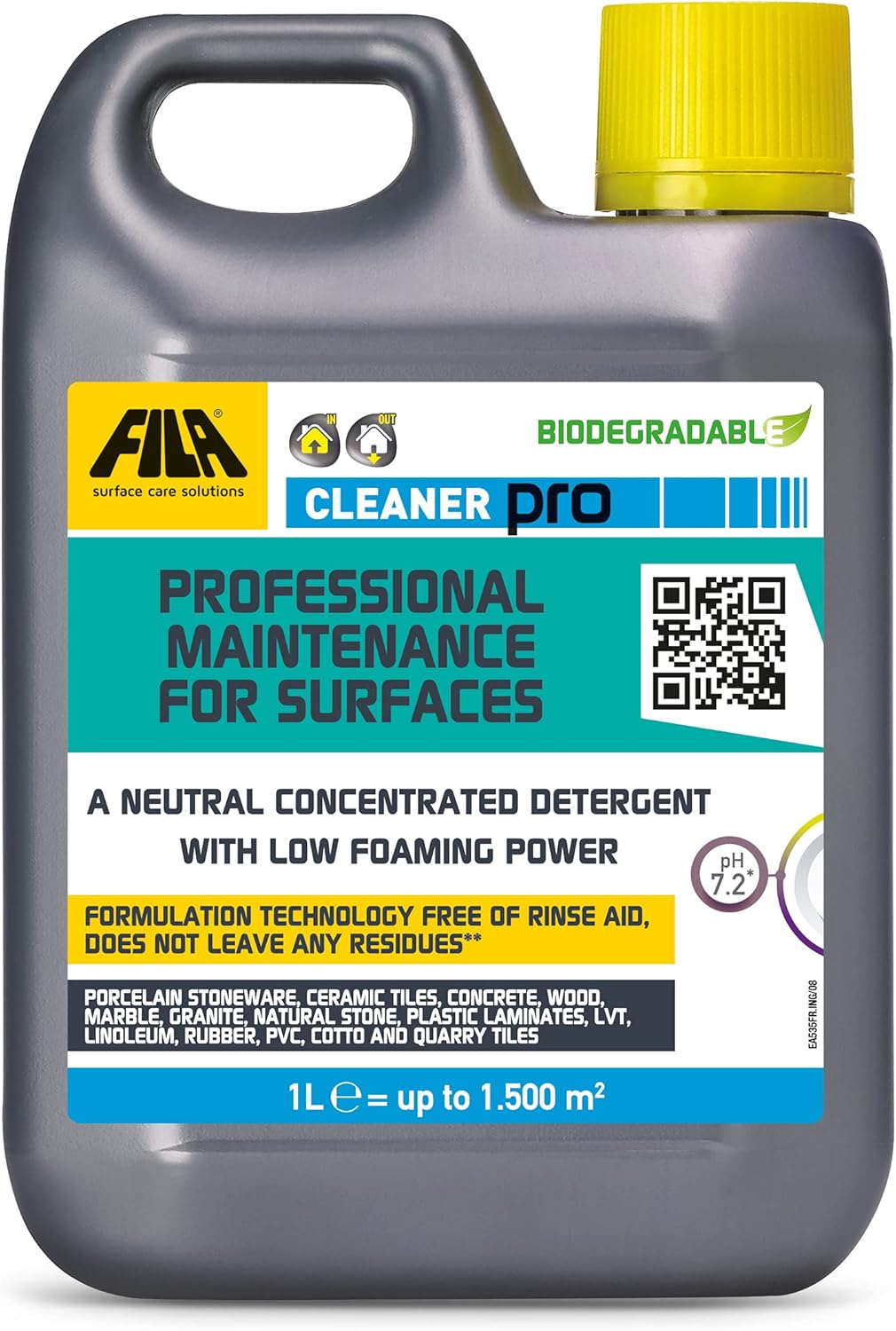
Fila Pro Floor Cleaner
|

LTP Colour Intensifier & Stainblock H20
|
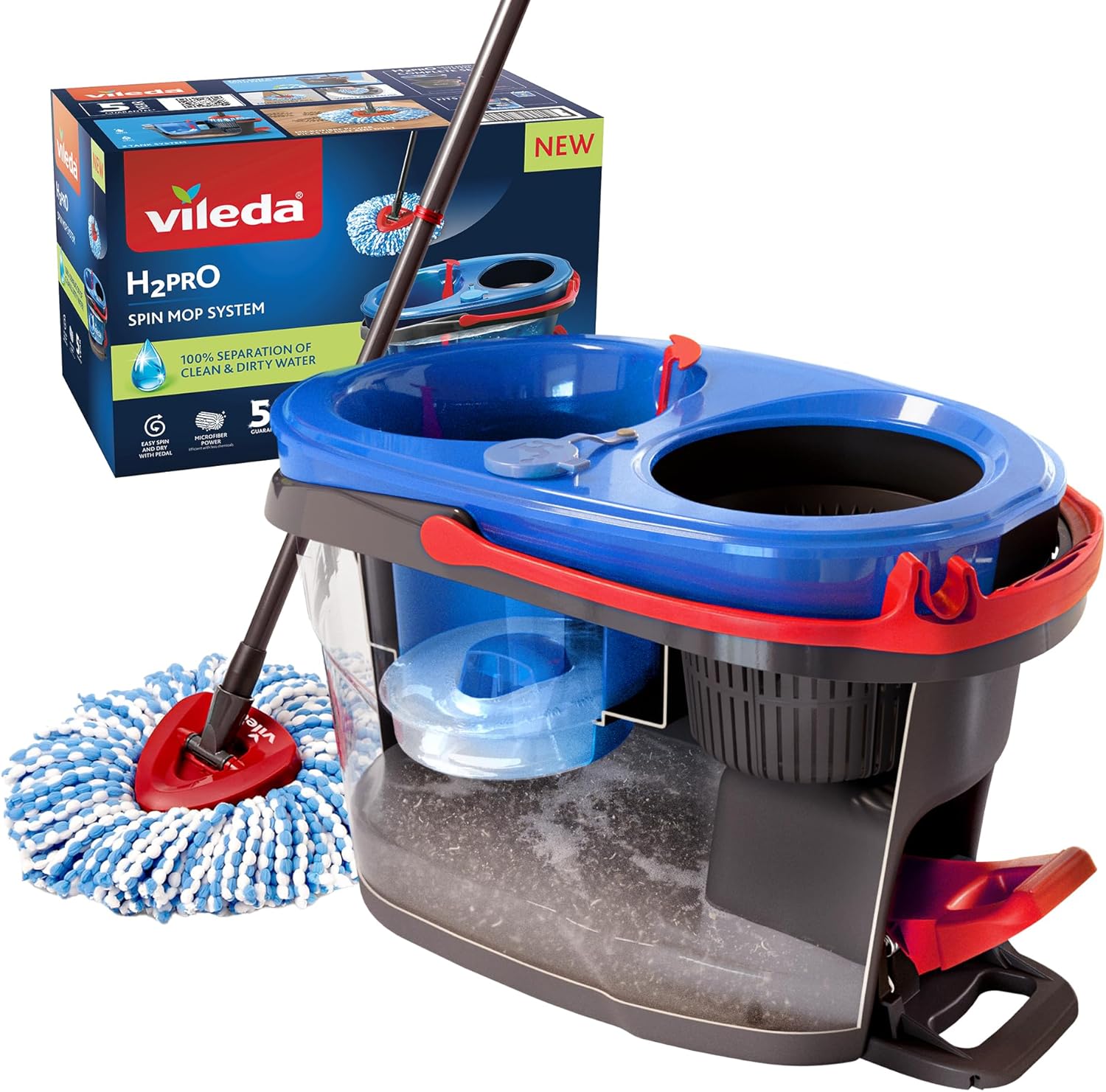
Vileda H2PrO Spin Mop System
|
However, over time, these tiles can often lose their aesthetic charm due to various influences such as surface wear, chemical interactions, and environmental factors. Revitalizing their original vibrancy is a specialized task that requires a deep understanding of the materials involved, historically accurate techniques, and high-quality products specifically tailored for Victorian tile restoration.
Identifying Key Factors Leading to the Fading of Victorian Mosaic Tiles
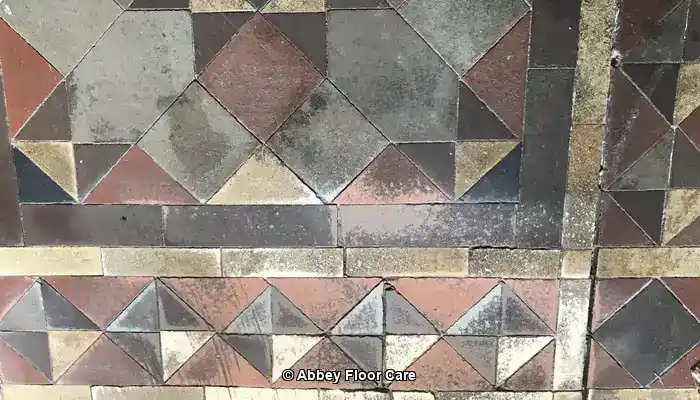
Example of Victorian Clay Tile Floor dulled through surface wear and damage.
Despite the inherent pigments embedded in the tile, various factors contribute to fading and dullness:
- Accumulated dirt and grime: Continuous foot traffic leads to the deposition of fine particles and oils that penetrate porous surfaces, scattering light and dulling the vibrant colours.
- Wax and polish accumulation: Layers of wax or sealants that lack breathability can trap moisture, resulting in a cloudy or yellowed appearance that detracts from the beauty of the tiles.
- Moisture-related issues: Many Victorian tiles were installed over subfloors lacking damp-proof membranes, leading to rising damp that transports soluble salts to the surface, where they crystallize as efflorescence, further obscuring the original tones.
- Physical abrasion: Minor surface scratches accumulated over years of use disrupt smooth light reflection, diminishing the visual richness and vibrancy of the tiles.
A comprehensive restoration approach addresses each of these contributing factors without compromising the historic integrity of the tiles, ensuring that their original beauty is preserved for future generations to appreciate.
Understanding the Importance of Breathability in Restoration Without Damp-Proof Membranes
Given that many Victorian tiled floors exist atop older subfloors that lack a damp-proof membrane (DPM), it is crucial that their natural clay structure remains permeable. This permeability allows moisture from the subfloor to evaporate effectively. Non-breathable wax coatings or film-forming sealers can block this essential evaporation pathway, leading to moisture buildup beneath the surface. This trapped moisture can cause salts and humidity to accumulate, resulting in efflorescence, degradation of surface minerals, and the undesirable occurrence known as wax blooming—a whitish haze on the tile. Restoration strategies must prioritize breathable impregnating sealers that protect the tiles while allowing moisture vapor to escape freely, thus preventing long-term damage.
Exploring the Role of Pigments and Tile Composition for Successful Restoration
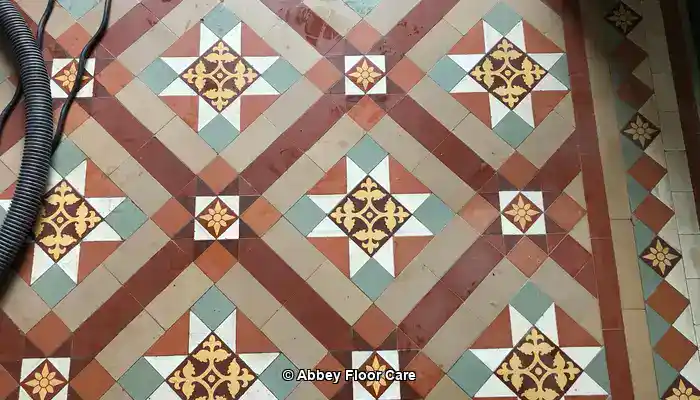
An example of different pigments in a Victorian Clay tile floor during restoration by Abbey Floor Care
Uncovering the Impact of Mineral Oxide Pigments in Victorian Tiles
Victorian mosaic and encaustic tiles derive their distinctive earthy hues from mineral oxide pigments that are embedded directly into the clay. These pigments not only enhance durability but also contribute to colour depth. The primary pigments include:
- Iron oxide: produces terracotta reds, rust browns, and soft ochres.
- Manganese: generates deep browns and rich blacks.
- Cobalt: contributes various blue shades, enhancing the overall visual appeal.
- Chromium: creates vibrant green tones, adding to the spectrum of available colours.
Understanding the Firing and Fusion Process in Tile Creation
During manufacturing, the tiles are fired at temperatures around 1100°C, which vitrifies the clay and fuses the pigments deeply into the body of the tile. This process ensures that the colour permeates throughout the tile rather than merely existing on the surface, thereby offering long-lasting vibrancy and stability in appearance, which is crucial for maintaining the integrity of the tiles over time.
Examining the Porous Unglazed Finish of Victorian Tiles
Victorian tiles typically display a porous, unglazed matte finish that provides a natural look. However, this porosity makes the tiles absorbent and susceptible to surface contamination and moisture, necessitating careful cleaning and maintenance practices to ensure their longevity and aesthetic appeal.
Recognizing the Variability in Colour Durability of Victorian Tiles
Natural earth pigments, especially those in red and yellow tiles, contain fewer mineral additives than darker colours like black, which are formulated with manganese. This disparity means that red and yellow tiles are often less durable and more prone to surface dishing under heavy foot traffic. Over time, this wear manifests as shallow depressions in areas of concentrated footfall, leading to uneven colour intensity and a loss of surface flatness, which underscores the necessity for diligent restoration efforts.
Strategic Considerations for Restoration Planning of Victorian Tiles
A comprehensive understanding of pigment composition and wear patterns is essential for effective restoration planning. Softer-toned tiles require gentler cleaning methods and specially formulated impregnating sealers that respect their physical properties while enhancing colour vibrancy. In contrast, darker, harder tiles can endure more intensive cleaning but still require breathable, colour-enhancing protection to maintain vibrancy over time, ensuring favorable restoration outcomes.
Executing Effective Cleaning Techniques for Victorian Mosaic Tiles
Thorough cleaning is vital for restoring Victorian encaustic and mosaic tiles to their original vibrancy. However, the cleaning of these tiles demands a specialized approach that goes beyond using simple pH-neutral detergents. Professional restorers utilize carefully formulated alkaline cleaners and mechanical techniques to break down heavy soiling and old residues while preserving the historic fabric of the tiles, ensuring that restoration efforts yield the best results possible.
Beginning the Cleaning Process: Removing Debris for Optimal Restoration
The cleaning process starts with the meticulous removal of all loose dirt and grit through the use of soft brushes or vacuuming with brush attachments. This step is critical to prevent scratches on the delicate tile surfaces during the subsequent cleaning phases, ensuring that the restoration process is effective while maintaining the integrity of the tiles.
Employing Alkaline Cleaners for Intensive Soil Removal
Unlike standard pH-neutral cleaners, which might lack the necessary chemical strength to address ingrained fatty acids and organic soils, alkaline cleaners are essential for effectively breaking down household oils, grease, and sticky residues commonly found on tile surfaces and within grout lines. These alkaline formulations dissolve the binding agents of dirt, sugars, and fats, facilitating their efficient removal while remaining compatible with the mineral composition of Victorian tiles.
Professionally used alkaline products, such as PS87 PRO or specially crafted formulations from heritage cleaning specialists, are typically used in a diluted form. This approach ensures deep cleaning without being excessively aggressive on the clay body. It is important to note that even when using alkaline cleaners, caution is necessary, and spot testing is highly recommended to prevent any adverse reactions that could compromise the integrity of the tiles.
Augmenting Cleaning Efficiency through Mechanical Agitation Techniques
Mechanical action greatly enhances the effectiveness of the cleaning process. Low-speed rotary scrubbers fitted with red or occasionally green non-abrasive pads are often employed to agitate soil out of small pits, tile surfaces, and grout lines. These pads clean thoroughly while protecting the integrity of the tile edges and delicate surface details, ensuring that the cleaning process is both effective and respectful of the historical value of the tiles.
Removing Waxes and Old Sealants Accumulated Over Time
Years of usage often result in the buildup of old waxes and sealants, particularly from DIY attempts using inappropriate products. Water-based cleaners—whether alkaline or mildly acidic—are preferred for removing these residues without damaging the mineral structure of the tiles. However, stubborn ‘exotic’ or solvent-resistant coatings might require targeted solvent-based removers like <em>Lithofin Wax-Off</em> or LTP Solvex. These solvents effectively soften and emulsify waxes and old sealants but must be utilized carefully by professionals trained in their safe application and disposal to prevent any potential damage to the tiles.
The Significance of Rinsing and Drying After Cleaning
Following chemical cleaning, thorough rinsing is crucial to eliminate any remaining cleaning residues. Multiple rinses with clean water, combined with wet vacuum extraction, ensure that no detergent or solvent traces linger to interfere with subsequent restoration treatments. Drying time varies based on environmental factors such as humidity, surface type, and moisture content. Restoration experts always utilize moisture meters to verify that the tiles are completely dry before applying any impregnating sealers or protective treatments. This meticulous approach prevents moisture entrapment, which could otherwise result in efflorescence, staining, or damage beneath sealed layers.
Recognizing the Importance of Thorough Cleaning in Restoration
Comprehensive cleaning reveals the true condition of the tiles by removing visual obstructions. It exposes areas that may require repair and provides a clean, receptive surface for colour-enhancing impregnators or other restorative products. This careful preparation is paramount to the success and longevity of Victorian mosaic tile restoration, ensuring that the end result is both visually appealing and durable.
Enhancing Colour with High-Quality Impregnating Sealers for Long-Lasting Results
Restorers utilize impregnating colour-enhancing sealers produced by LTP and Lithofin, brands recognized for their innovative, heritage-approved formulations. Unlike superficial coatings, these sealers:
- Penetrate deeply into tile pores to physically enrich colour by altering light refraction, enhancing the overall aesthetic appeal.
- Maintain vapour permeability, which is essential for moisture escape and particularly critical in older floors lacking DPM layers.
- Provide durable protection against stains and foot traffic without changing the natural texture or gloss of the tiles, ensuring their integrity remains intact.
- Applied in multiple light coats, each allowed to penetrate fully before the next is applied, ensuring uniformity and effectiveness while maximizing the benefits of the sealer.
These sealers directly address fading issues by restoring vibrancy while preserving the breathable nature of the historic floor, ensuring that the restoration process is both effective and respectful of the tiles’ original characteristics.
Repairing Damaged Tiles and Techniques for Authentic Colour Tinting in Restoration
Tiles that display chips, cracks, or missing pieces require careful repair using tinted epoxy or lime-based mortars, colour-matched with natural mineral oxides. Restoration professionals often source matching replacement tiles from salvage archives to maintain pattern continuity. Colour tinting involves the selective application of earth-pigment-infused wax or resin mixtures to blend worn or missing pattern areas sensitively while respecting both tile breathability and reversibility in the restoration process.
Best Practices for Effective Tinting for Seamless Integration
- Utilize small, controlled applications to prevent excessive colouring that may detract from the natural aesthetics and charm of the tiles.
- Conduct patch testing on inconspicuous areas before full-scale application to ensure colour compatibility and effectiveness.
- Ensure compatibility with the impregnating sealers applied to the entire surface, maintaining a cohesive finish and enhancing the overall appearance.
Ensuring the Longevity of Restored Victorian Mosaic Floors Through Care and Maintenance
Preserving restored colour and condition necessitates ongoing care:
- Routine cleaning using pH-neutral, non-abrasive detergents specifically formulated for historic tiles, ensuring they remain in optimal condition.
- Implementing preventive measures, such as placing entrance mats to minimize dirt ingress and wear, significantly extending the life of the tiles.
- Promptly addressing liquid spills, particularly acidic substances like vinegar or wine, to prevent surface etching and damage, thus maintaining the integrity of the tiles.
- Regularly reapplying breathable impregnating sealers every 3–5 years or as wear dictates to uphold optimal protection and appearance.
- Monitoring floors for signs of efflorescence or moisture ingress, which may indicate underlying damp issues that require immediate attention to prevent further damage.
Avoiding Common Restoration Errors for Successful Outcomes
- Avoid wax treatments that can obstruct breathability, leading to efflorescence or the development of wax blooming, which tarnishes the tiles’ beauty.
- Do not use acrylic or polyurethane sealants that can trap moisture and cause degradation of the tiles over time, compromising their structural integrity.
- Limit the use of harsh chemical cleaners, as they can erode clay and pigments, undermining the tiles’ longevity and aesthetic appeal.
- Never repaint tiles; paint films alter their visual and physical properties and are irreversible, detracting from their historical character.
- Recognize and address issues in older subfloors before sealing to prevent future complications that could affect the integrity of the tiles.
Highlighting Real-World Restoration Projects: Success Stories and Transformations
Examples illustrate the successful application of these principles:
Victorian Hallway Restoration in Sheffield: A Case Study of Excellence
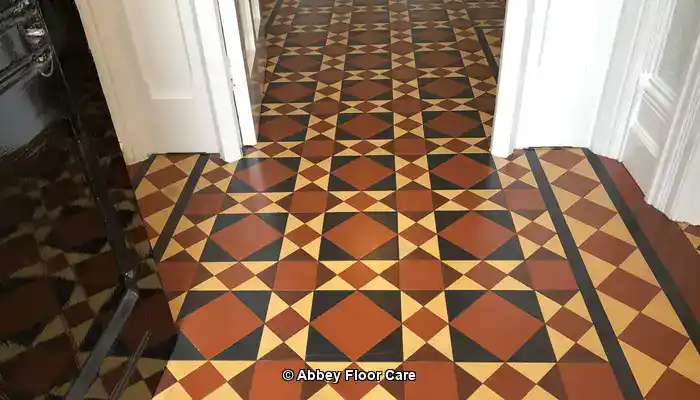
Our cleaning process effectively removed years of wax and grime, followed by the application of a Lantania Avo colour-enhancing impregnating sealer, which visibly deepened the tile colours. This was subsequently followed by the application of an acrylic topical sealer to provide surface protection on floors installed over a damp-proof membrane, ensuring their long-term durability.
Civic Mosaic Floor Restoration in Chesterfield: A Successful Transformation Story

After meticulously cleaning and removing old topical sealers, the floor was sealed with an LTP Colour Enhancing Impregnating sealer. The surface was further protected with a wax, carefully applied to seamlessly integrate the clay tiles into the historic fabric of the building, thereby ensuring a cohesive aesthetic throughout.
Preserving Heritage Through Expert Restoration Practices: The Essential Role of Authenticity
Restoring the colour and pigment of Victorian mosaic tiles is a multifaceted task that balances material science, craftsmanship, and a profound respect for heritage values. Utilizing premium impregnating colour-enhancing sealers from industry leaders like Dry Treat, Lantania, and Lithofin ensures long-term breathability, protection, and vibrancy. Skilled cleaning, careful repair, and diligent maintenance not only preserve authenticity but also revitalize these historic floors for future generations to appreciate and enjoy.
Addressing Frequently Asked Questions About Victorian Tile Restoration: Expert Answers
What are Victorian mosaic tiles and their significance?
Victorian mosaic tiles are decorative tiles that gained prominence in the 19th century, celebrated for their vibrant colours and intricate patterns. They were widely used in public buildings and private residences, significantly contributing to the architectural beauty of the era.
How can I effectively restore faded Victorian mosaic tiles?
Restoring faded Victorian mosaic tiles involves a comprehensive process that includes thorough cleaning, repairing any damages, applying new pigments to accurately match the original colours, and subsequently sealing the tiles to protect them from future deterioration.
What materials are essential for tile restoration?
Essential materials for successful tile restoration include specialized cleaning solutions, pigments, adhesives, grout, and protective sealants, all selected for their compatibility with the original tiles to ensure a harmonious and effective restoration process.
How long does a typical tile restoration project take?
The duration of tile restoration projects can vary significantly based on the size and condition of the area being restored, typically ranging from a few days for smaller projects to several weeks for larger restorations that require more intricate work.
Can I undertake the restoration work myself?
Yes, smaller restoration projects can be approached as DIY tasks if you possess the necessary skills and tools; however, more complex repairs generally require professional expertise to guarantee high-quality results that respect the tiles’ historical value and integrity.
What is the cost associated with restoring Victorian mosaic tiles?
The costs for restoration can vary considerably based on the project’s size and condition, ranging from a few hundred to several thousand pounds for comprehensive restorations that address extensive wear and damage, reflecting the intricacies involved.
How do I choose the right restoration expert for my needs?
When selecting restoration professionals, consider individuals with experience in historical projects, positive reviews, and a commitment to using authentic materials and techniques that align with best practices in heritage conservation, ensuring successful outcomes.
What challenges do restorers commonly face during the restoration process?
Restorers often encounter challenges such as accurately matching original colours, repairing damaged tiles, and ensuring the longevity of the restoration work while preserving the historical integrity of the tiles, necessitating expertise and careful planning.
How can I maintain my restored tiles effectively over time?
To maintain restored tiles, engage in regular cleaning with pH-neutral products, avoid harsh chemicals, reseal periodically, and promptly address any signs of damage to protect and preserve the tiles’ condition and aesthetic appeal.
What innovations are currently shaping tile restoration practices?
Recent innovations in tile restoration include the development of advanced cleaning solutions, new types of sealants, and digital technology that allows for precise colour matching and pattern replication in restoration projects, enhancing overall effectiveness and results.
The article Restoring Colour and Pigment to Faded Victorian Mosaic Tiles was first published on https://www.abbeyfloorcare.co.uk
The Article Restoring Colour to Faded Victorian Mosaic Tiles appeared first on https://fabritec.org
The Article Restoring Victorian Mosaic Tiles to Their Original Color Was Found On https://limitsofstrategy.com
The Article Restoring Original Colour of Victorian Mosaic Tiles First Appeared ON
: https://ad4sc.com










No responses yet